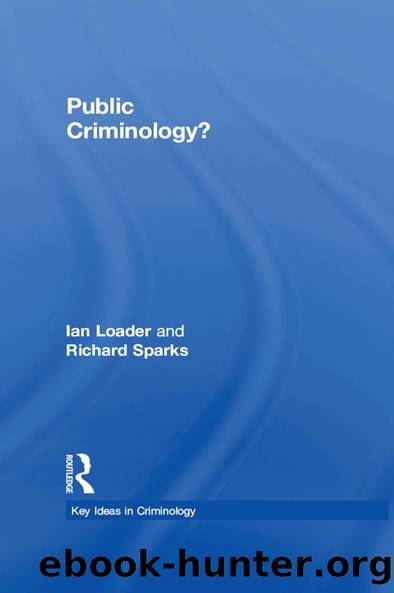Public Criminology? by Ian Loader Richard Sparks

Author:Ian Loader, Richard Sparks [Ian Loader, Richard Sparks]
Language: eng
Format: epub
Tags: Social Science, General, Criminology
ISBN: 9781136931536
Google: 5ZGEW_C1Ob0C
Publisher: Routledge
Published: 2013-05-13T03:44:09+00:00
INVENTING TECHNIQUE(S)
We turn now to two cooling devices that are of more recent vintage, modes of intervention that are less securely located within criminology's history and constitutive ways of thinking.19 The first seeks to transcend the established limits and institutions of criminology in the name of a new multidisciplinary mode of studying and improving crime prevention and detection â nothing less than a âcrime scienceâ. The coolant which this new science offers is one that seeks to de-dramatize crime and criminals and to prioritize the search for practical techniques that will reduce crime's impact upon everyday life. The second brings legal and political scholars to criminology's domain concerns in order to warn against the deleterious consequences of the politicization â or, in our terms, heating up â of criminal justice and penal policy. The response of these scholars to the dangerous entangling of democracy and penality is to invest in bureaucratic authority and expertise, and to press the case for re-insulating criminal justice policy and practice from the surrounding heat. Let us consider these two responses in turn.
Crime science, as the name implies, is the âapplication of the methods of science to crime and disorderâ (Laycock 2001: 4). It aims to deploy those methods â the hallmark of which it takes to be the generation, replicable testing and revision of hypotheses â in the service of preventing and reducing crime, thereby âimproving the scientific basis of crime policyâ (Clarke 2004: 56; see also Pease 2005). This science has been incubated in new institutions, notably the Jill Dando Institute for Crime Science at University College London, and has ambitions to grow internationally from that base.20 It proposes to draw widely from across the social and physical sciences, not only upon criminology, but from psychology, geography and sociology and from chemistry, engineering, genetics and physics. Its stated purpose is to âchange the way in which we think about crime and its controlâ and to confront with good, tested ideas a crime control landscape which âremains doggedly based on intuition, anecdote, received wisdom and untutored opinionâ (Laycock 2001: 2, 5).
Crime science has its roots, theoretically, in rational choice theory (Cornish and Clarke 1986) and its close cousin routine activities theory (Cohen and Felson 1979), as well as a practical precursor in the situational crime prevention movement that developed in the early 1980s (Clarke 1983). This body of theory and practice took issue with a field of criminology that it saw as committed to âideals of enlightening society about crime, of helping to fashion a humane criminal justice system, and of helping reform criminalsâ (Clarke 2004: 61). But it also challenged many settled social assumptions about criminals and crime control. It broke first with what Ron Clarke (1983) called âdispositionalâ accounts of offenders and offending â the idea that criminals are different from the âlaw-abidingâ, predisposed by their psychological traits, or socialization, or material plight to break the law. Crime, the argument runs, is not committed by âbad peopleâ or people from bad backgrounds
Download
This site does not store any files on its server. We only index and link to content provided by other sites. Please contact the content providers to delete copyright contents if any and email us, we'll remove relevant links or contents immediately.
The 1921 Tulsa Race Massacre by Chris M. Messer(288)
Introduction to Criminal Justice - A Balanced Approach by Brian K. Payne Willard M. Oliver Nancy E. Marion(255)
Punishing the Poor The Neoliberal Government of Social Insecurity by Unknown(250)
Russia's Sakhalin Penal Colony, 1849â1917 by Andrew A. Gentes(249)
The History of Newgate Prison by Jowett Caroline;(236)
Serial Killers America and UK - 2 BOOKS IN 1 by Clark Matthew(211)
A History of Police and Masculinities, 1700-2010 by David G. Barrie Susan Broomhall(197)
Restorative Justice in Transitional Settings by Kerry Clamp(169)
Organized Crime and Corruption Across Borders by T. Wing Lo Dina Siegel Sharon I Kwok(159)
Culture, Crime and Punishment by Ronald Kramer(156)
Dangerousness, Risk and the Governance of Serious Sexual and Violent Offenders by Karen Harrison(156)
Cops, Cameras, and Crisis by Michael D. White Aili Malm(154)
Policing Gender, Class And Family In Britain, 1800-1945 by Linda Mahood(153)
Routledge Handbook on Immigration and Crime by Holly Ventura Miller Anthony Peguero(152)
The Real CSI by Kate Bendelow(150)
Women Exiting Prison by Bree Carlton Marie Segrave(144)
Losing Legitimacy by Gary Lafree(139)
Using Murder by Philip Jenkins(138)
A Theory of African American Offending by James D. Unnever Shaun L. Gabbidon(136)
